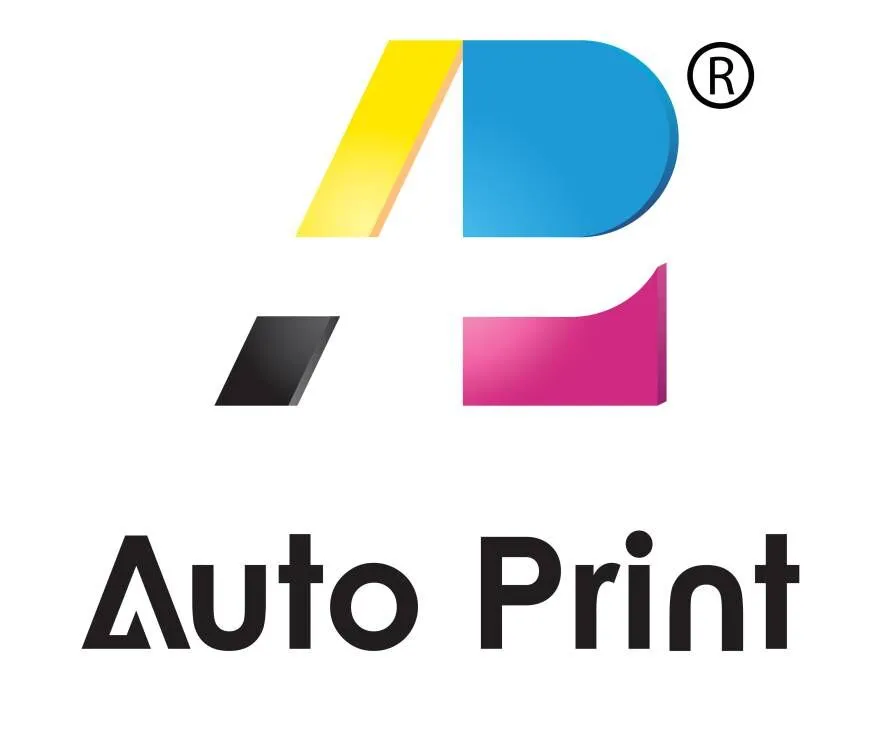Introduction
Screen printing is almost universal because it’s the most common and convenient way to print T-shirts. Flatbed and rotary screen printing are two of the most commonly used methods. For the time being, we’ll focus on flat-screen printing and the flat bed screen printing press as the primary printing methods.
Are there any positive or negative aspects to flat bed screen printing? When it comes to large-scale manufacturing, is this printing technology the best bet? Let us know in the next blog post.
Flat bed Screen Printing Definition
Flatbed Printing nowadays is an automated form of printing on a silkscreen that was previously done by hand. Instead of printing an endless pattern, flat screens produce prints with a specific, fixed area. Each color and design theme has its own screen. Because the squeegees may be used several times on each screen, a considerable volume of print paste can be applied.
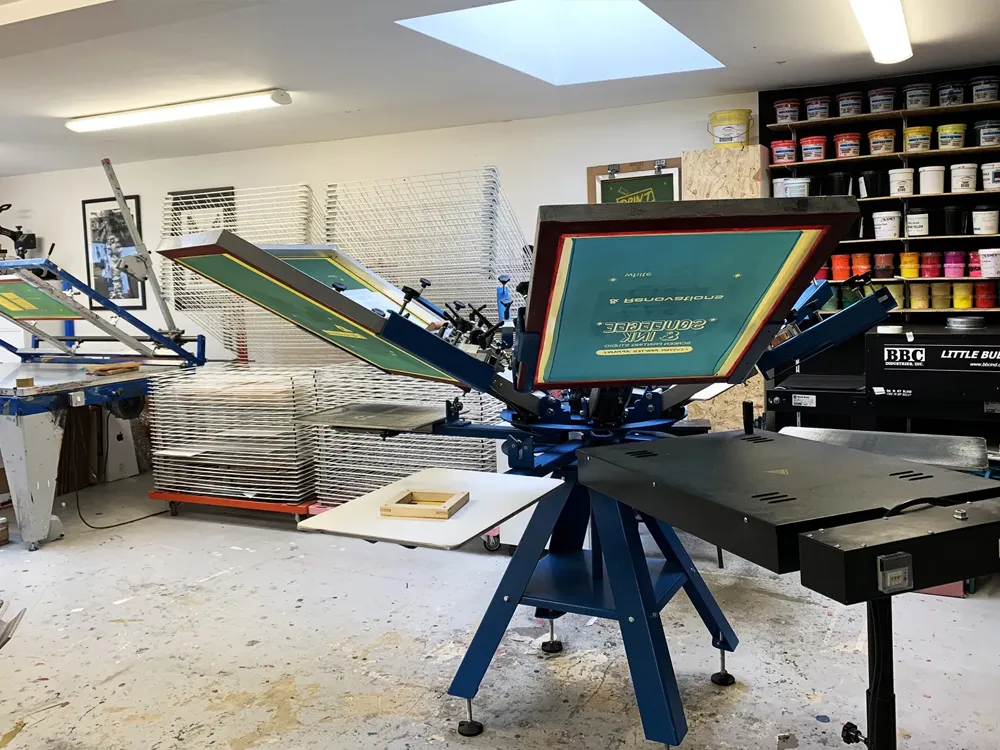
How Does Flat bed Screen Printing Work?
Machines that automatically print screens on a flatbed surface are common in printing establishments. Semi-automatic and manual versions of the flatbed screen printing machine are also possible.
- First, the cloth is glued to a moving belt on a flat bed screen printing machine. Lower the front screen of the machine to the printing area and use a squeegee to remove the printing paste.
- Then, lower the screen and advance the belt on which the cloth is bonded to the repetition point. The printed cloth is put through its paces and then dried at the end of the process.
- In a flat bed screen printing press, only one color may be printed. In order to complete printing, the pattern, the dried cloth must go through a second printing cycle after it has been printed with the first color.
Flat bed Screen Printing Process
Through a feeding mechanism, the fabric is delivered onto the printing table and stuck to the conveyer belt on the table. Gumming is done by using a two-shaft peddler, in which the bottom shaft spins in a gum box, transferring the gum to the upper shaft, which in turn conveys it to the conveyer belt.
The fabric is conveyed beneath the screens on a regular basis, and the screens are lowered onto the fabric using a unique mechanism while the conveyer is stopped. The screens are raised again after the squeegee has made a few strokes over them.
Flexible pipes transport and pour printing paste produced in tanks onto the screen. Then, it’s spread out over the whole screen. The squeegee holders have dynamometers at the ends of them that force the squeegee onto the screen.
Patterns may be printed simultaneously by using one or more strokes of a squeegee to apply the printing paste to all screens simultaneously. Underneath the table, a dedicated conveyer collects any excess paste. In order to dry the cloth, it is put into a hot air chamber. Returning to its previous position, it is cleaned and dried before a fresh fabric is applied to it.
Compared to traditional hand screen printing, this machine produces more printed fabric and allows for more precise registration of designs with varied repetitions. Squeegee strokes of up to six may also be used for printing. Mechanization makes the process quicker and more efficient, while still preserving the benefits of screen printing.
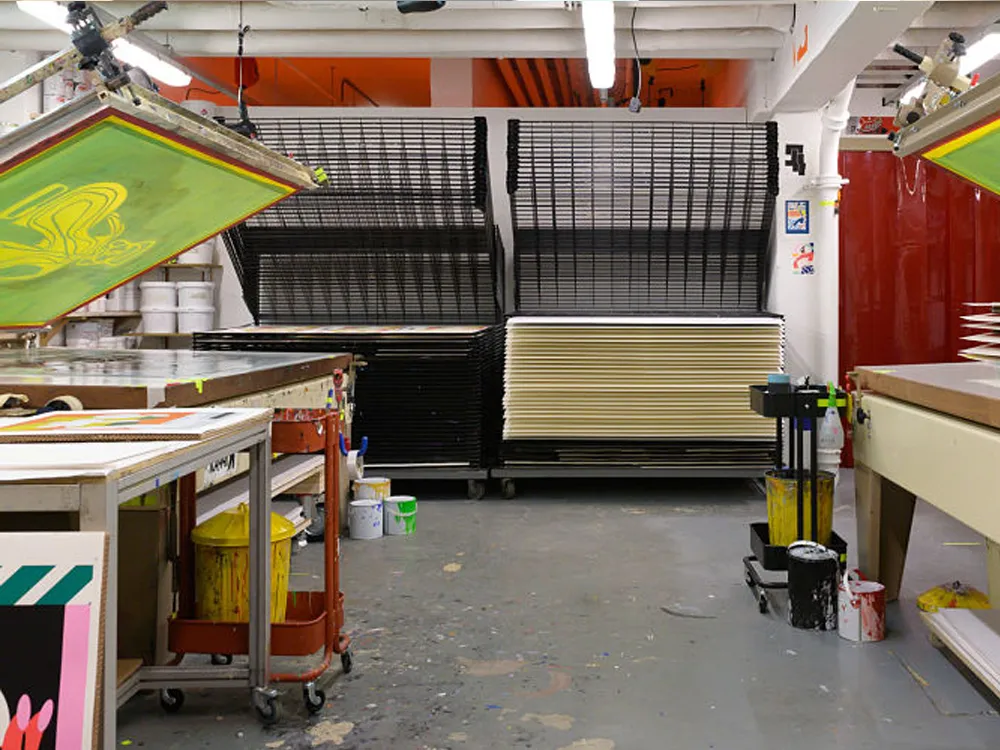
Pros of Flat bed Screen Printing
Cost-effective
Flat bed screen printing has 13 benefits and drawbacks. Automatic flatbed screen printing has the benefit of lower flat bed screen printing press costs. When it comes to decorating woven and knitted materials, flatbed screen printing is the best option.
It’s also a cost-effective way to print patterns of up to 24 colors on terry towels, single jerseys, silk sateen’s, and terry towels, among others. Screen printing on ornamental textiles became more affordable and better in the early 1900s when flatbed printing was introduced. Flatbed screen printing still has a big advantage over rotary screen printing because of the low price of the flatbed screen printing machine.
Prices in Bangladesh range from 3000–4000 TK for a flat-bed screen printing machine. However, rotary screen-printing costs 5k–6k BDT depending on the diameter of the screen, making it more expensive than other printing methods.
Screen printing on flatbeds is best suited for big runs since it necessitates the creation of a screen for each color in an artwork. The cost of an automated flatbed screen printing machine drops as the quantity of clothing ordered rises.
Versatile
The flat bed screen printing press has 13 benefits and drawbacks. Flatbed screen printing presses have the benefit of being versatile. Flatbed screen printing is the most flexible printing technology since it can be used to print on a wide variety of clothes. It is possible to print on a wide range of flat surfaces using flatbed screen printing.
A wide range of design dimensions is possible with flatbed screen printing since it supports all screen sizes.
Rotary screen printing cannot print CMYK designs precisely, but a flat-bed screen printing machine can. With no metal (nickel) in the cloth, it will pass the nickel test, but rotary screen printing will fail.
It is long-lasting and sturdy
Flat bed screen printing has benefits in terms of durability and long-term use. Flatbed screen printing produces a product that can endure far more stress than other methods because of the thickness and nature of the ink used. Printing on a flatbed screen won’t damage the screen at all while the machine is functioning.
A rubber squeegee is used in flat bed screen printing, whereas rotary screen printing uses blades or stainless-steel rollers of various diameters to prepare the color for printing on the cloth. Flatbed screen printing, on the other hand, will produce join or repetition marks that rotary screen printing just can’t do when printing a pattern that covers the whole body.
More Colors & Different Inks
The benefits of flatbed screen printing include the ability to print with any desired ink deposit and any ink system. If you use a flatbed screen printer, you can thicken the ink so that you can print on more fabrics and patterns.
It is possible to print more than 12 colors with flatbed screen printing. Rotary screen printing has a color gamut of up to twenty, but due to the difficulty of the machine setup, it is generally limited to 12 or fewer shades.
Better Results
Flat bed screen printing has the benefit of delivering superior results. Improved registration, various colors, and larger sizes are all possible thanks to flatbed screen printing. Screen printing on a flatbed is the automated version of silkscreen printing, which uses a custom-made screen for each color and design motif.
There is no continuous pattern with flatbed screen printing, just a fixed region. Fine lines as well as entire surfaces can be printed using automated flatbed screen printing equipment.
Because of this, printers are now able to print with more color and volume intensity, or even the finest detail.
In order to apply huge volumes of print paste, several squeegee strokes might be used on each screen. Flatbed screen printing is superior to rotary screen printing in terms of design sharpness and smoothness.
One-pixel line, spray, or dot patterns may be printed correctly in a laser exposure machine with flatbed printing since they are difficult to produce with rotary printing. Due to the fact that each customer’s design is printed on a flatbed screen, this is an ideal way to make screens.
Various Measurement
Flat bed screen printing has the benefit of allowing for a wide range of design measurements. The merging of flatbed screen printing with semi-rotary offset printing equipment is its most important breakthrough.
As a result, the flat screen-printing method is able to accommodate a variety of screen sizes. Since developers construct design repeats by computing the diameter of the screen during the design process of a rotary screen, the normal circumference or diameter for rotary screen printing is 641–1018 mm.
Reduced Pollution
Flat bed screen printing results in less color waste when color is manually applied to the flatbed screen. Rotary screen printing has a larger color waste than flatbed printing because color is immediately transferred to the rotary screen from the drum, which is helped by the flatbed printing press.
Simplicity
Flatbed screen printing has the benefit of being simple to use. Because the screen moves slowly up and down in a flatbed screen printing press, pinholes are less likely to appear than they are in a rotary screen-printing press.
Fast screen rotation and machine operation necessitate periodic pinholes on the rotary screen. As a result, the screen must be removed from the machine and retouched to eliminate the pinhole. After that, it’s time to restart the machine so it can continue producing.
It’s quicker to prepare flatbed screens for screen printing since they can be exposed in 30 minutes or less. Rotating screens may take more than 30 minutes to prepare and print a single piece.
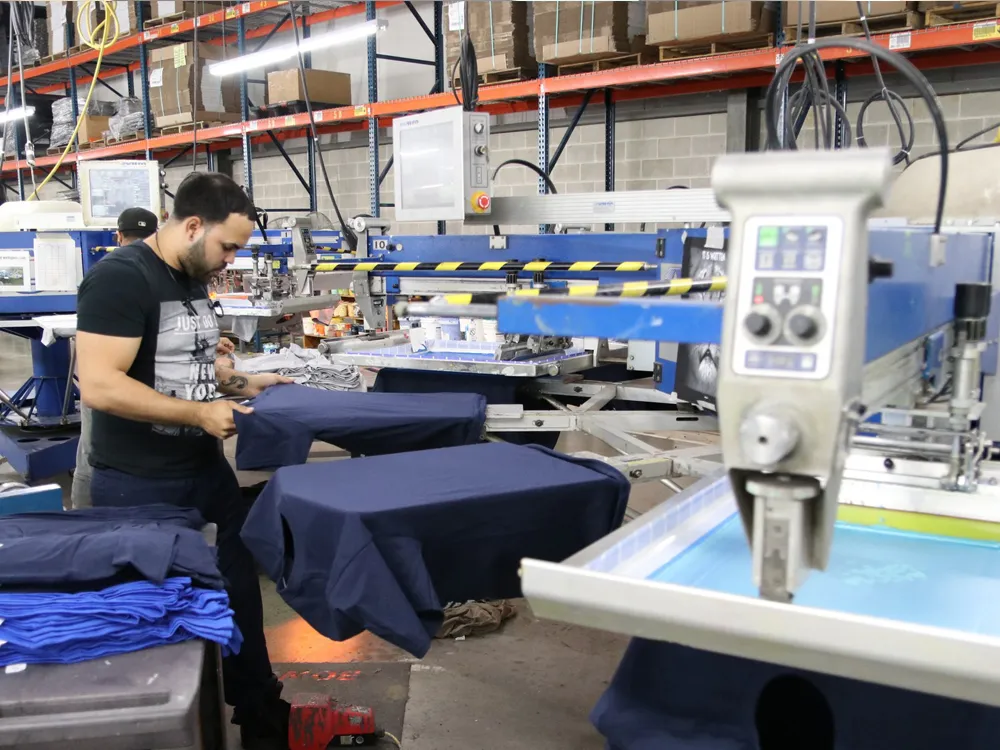
Cons of Flat bed Screen Printing
Material handling is more difficult
Flatbed screen printing has a drawback in terms of material management. Post-print processing includes drying equipment.
A rewinding unit, finishing, or printing operation may then be used in conjunction with the flatbed printing press to complete the process. When printing on a flatbed or multicolor in-line system, it takes longer and more laborious handling procedures to transport the produced sheet to the finishing area.
Combining printing
Flatbed screen printing has a drawback when it comes to combining prints. Flatbed screen printing may be used for a wide range of tasks that aren’t achievable with rotary equipment, such as printing hard material. When it comes to in-line combination printing on rotary screens and flatbed screens alike, there is one area where they differ:
Flat Screen vs. Rotary Screen Printing
There are a lot of different screen printing processes, so we may talk about the difference between flat and rotary screen printing:
- To print on a screen that goes up and down in flat screen printing, the screen has to be flat. The rotary screen, on the other hand, is round in shape and revolves.
- Using the squeeze is common in flat screen printing. Only one roller is utilized in rotary screen printing.
- For small-width cloth (45-50′′), flat screen printing is used.A large-width cloth is printed using rotary screen printing on the opposing side of the fabric.
- Only six to eight colors are available in flat screen printing patterns. However, if you employ rotary screen printing, you may use up to 24 colors in a single design.
- Flat screen printing has a lower output rate than other printing methods. Rotary screen printing, on the other hand, is far quicker than flat screen printing, with a threefold increase in output.
- Flat screen printing machines have cheap initial investment costs, making them more affordable. A significant part of the initial investment in rotary screen printing is due to the high initial investment costs.
As a result of their high cost and high productivity, rotary screen printing machines are widely used in the modern textile sector.
Famous Flat bed Screen Printing Machine
Pneumatic Flat Screen Printing Machine
An OS pneumatic flat screen printing machine is a PCB board controlled and pneumatically powered economic type of equipment that operates quickly, steadily, and simply. For small-scale flat-goods printing, this flat-bed screen printer is ideal. Vacuum tables and T-slot tables may be used on the same worktable.
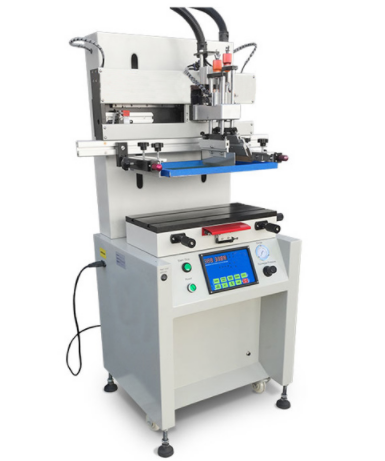
Electric Automatic Flatbed Screen Printing Machine
An AC motor drives the machine’s left and right movements, while a brand-name PLC controller and touch screen allow for the unit to be programmed. The operating performance of electric-driven machines is steadier than that of pneumatic-type machines.
Standard electric flat screen printers have print area sizes of 400x600mm, 300x500mm, 600x900mm, 500x700mm, 700x1200mm, and we can manufacture even larger print sizes, depending on the print area size. In addition to being a T-slot worktable, it may also be a vacuum table. This precise series of machines is commonly employed to print industrial products like transfer paper/decals, membrane switches, and dash boards (for cars).
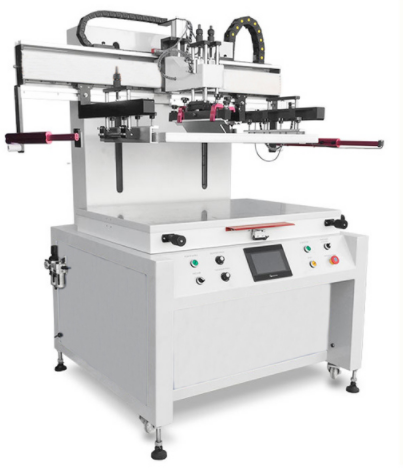
Semi Automatic Flatbed Screen Printing Machine with Rotary Table
Featuring a rotating table and semi-automatic operation, the OS-360F-400 is a flat screen printing machine. The maximum print size is 100x150mm, and there are four working stations on the PLC-controlled machine.
This flat-screen printer is ideal for flat-screen printing on tiny parts since it can be loaded and unloaded quickly while printing. Depending on the need, we may use a rotary table machine with up to eight stations or as few as six. And the work table may be vacuumed or not.
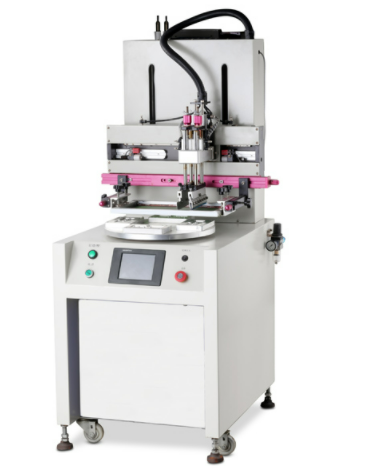
Final Thoughts
Electronic controls and automated functions are standard on all flatbed screen printers. On roll-fed machines, these characteristics reduce the need for tedious and time-consuming human adjustments.
Printing flatbed screens with nearly endless print sizes is possible thanks to custom-engineered flatbed screen printing lines that maximize productivity. Products needing precise ink thickness control, high volume manufacturing, and large-scale pictures are all good candidates for this sort of screen printing equipment.
